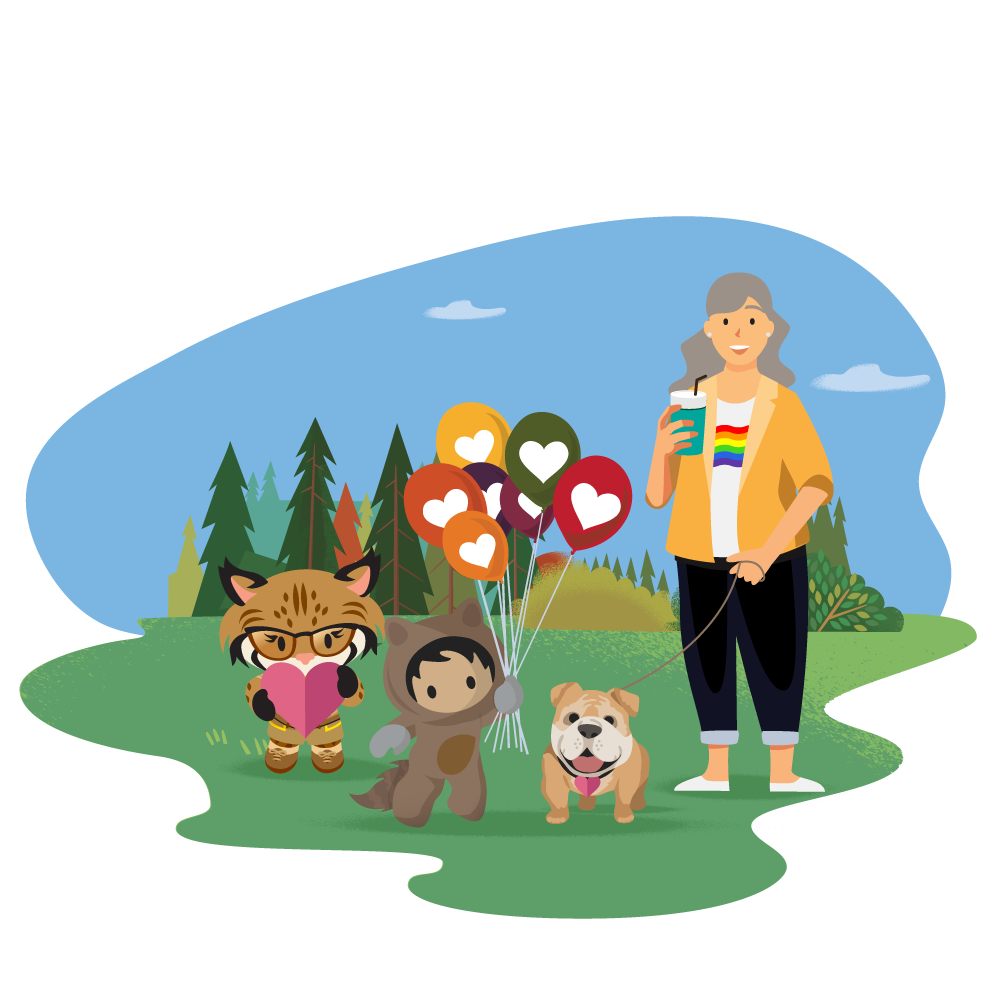Learn Why We Write the Way We Do
Learning Objectives
After completing this unit, you’ll be able to:
- Describe our voice and tone.
- Identify a writing sample that sounds like Salesforce.
How We Write Reflects Who We Are
This badge gives you an overview of the voice and tone we use in our writing at Salesforce. Why are you interested in our voice and tone? Maybe you’re a Salesforce customer or you’re curious about our products, and you want to get to know the company better. Maybe you work for Salesforce or one of our partners, and you want to write the Salesforce way. Or maybe you’re just wondering why writers make the choices they do, and what effect those choices have on the reader.
Whatever the reason, we’re glad you’re here. We hope this badge is helpful.
Values Come First
Salesforce is a values-driven company. Our founder, Marc Benioff, developed the V2MOM framework to help us clarify our vision and identify the values that guide everything we do. That means we think about our values when we write to make sure we’re creating content that reflects who we are and what we believe in.
Salesforce core values are:
-
Trust
-
Customer success
-
Innovation
-
Equality
-
Sustainability
These values remind us to create engaging, reliable content that helps everyone be successful.
We Write with Purpose
Before we start working on a new piece of content, we ask ourselves why. The world is full of things to read, watch, and listen to–we don’t want to add to the noise unless the thing we’re adding serves a purpose. It has to be useful for the people who will read it, because they’re busy, and their time is valuable. So we stay focused on what the reader’s goals are, and we keep things brief and clear, following these principles:
-
Action- and goal-oriented: Our content helps people do something that’s important to them.
-
Less is more: Our content is quick to consume.
-
Easy to understand: Our content uses everyday language, and it breaks new concepts and tasks into approachable chunks.
Sometimes these principles help us decide to reuse something we already have, instead of writing something new. And sometimes we even remove content, so that what’s left is easier to find and use.
Voice and Tone Are Different
Our voice expresses who we are as a company. It shows our personality, reflects our values, and stays consistent in everything we write. Our voice is always helpful, honest, inspiring, and has heart. We talk more about these qualities of our voice in a bit.
Unlike voice, which doesn’t change, our tone varies depending on the audience and their goals.
For example, an informal, slightly playful tone works for an audience that’s seeking out new knowledge and has some time to learn. Check out this snippet of a blog post about Slack:
Why is it called Slack?
What does Slack have in common with lasers and scuba diving? For one thing, you might not know that the name is an acronym: it stands for Searchable Log of All Conversations and Knowledge.
The post gives you a bit of interesting information (what “Slack” stands for) and makes the information memorable by adding a comparison to two seemingly unrelated (and kind of funny-sounding) words: laser and scuba. The tone is welcoming and inviting, and we hope it makes readers want to learn more about Slack.
When the audience is on the job and more pressed for time, we use a tone that’s brief, encouraging, and to the point. This example appears in a popup inside our software:
Influence Our Product Roadmap
Calling all admins! IdeaExchange Prioritization is now open. In just a few minutes, you can review top ideas and prioritize them for consideration in a future release.
In this case, the audience is admins, and their goal is to keep Salesforce running smoothly for their users. Because they might be in the middle of another task when they see the message, we make it quick to read and easy to dismiss, so we don’t disrupt their workflow. The tone is upbeat and professional, and we hope it lets admins know we value their opinion and respect their time.
Tone Varies; Voice Doesn’t
Those are just a couple of examples, but they show how tone changes depending on who the audience is and what they’re trying to do.
As we mentioned, our voice always stays the same, because it reflects our values, and those don’t change. Trust, customer success, innovation, equality, and sustainability–these values inspire us to make content that’s honest, helpful, inspiring, and has heart.
Our Content Is Honest
Trust is our #1 value, so we are truthful in our writing. That means:
- We’re honest and direct in our statements.
- We’re accurate, relevant, and complete.
- We’re a source of trustworthy information.

We believe that clear, direct communication builds trust. So we’re forthright in how we explain things, and we don’t sugarcoat bad news. We give people honest, accurate information they can rely on to make decisions and take action.
Our Content Is Helpful
Reading and taking in new information takes effort. In return for that effort, our content should help people do things they want to do. That means:
- We listen to our customers and solve their problems.
- We use plain language.
- We give them useful information, at the right time and in the right format.

People use Salesforce products, earn Trailhead badges, and participate in the Trailblazer community to achieve specific goals–goals like building a sales report, learning Apex, or becoming a better manager. Our job as writers is to make content that guides them along the way. And we write the way we would talk to a friend, choosing everyday words like use and more instead of more formal ones like leverage and additional. We even play Buzzword Bingo to make sure we’re using simple, common words instead of jargon.
It may not seem like a big deal, but we believe that plain language makes it more likely that people will understand our ideas–and reminds them that there’s a caring human behind the words.
Our Content Is Inspiring
At Salesforce, we believe that technology has the potential to change things for the better, but we also know that any change can be scary. So we try to write with intention. That means:
- We’re engaging.
- We’re optimistic.
- We create content that helps people succeed and feel confident.

We want people to feel inspired to join our community, learn our technology, and use our products. So we are positive and optimistic in the stories we tell. We build the confidence of our learners through engaging, hands-on activities and challenges. We encourage our audience to succeed at their companies and in their careers.
Our Content Has Heart
In everything we write, we try to sound human and approachable. That means:
- We’re empathetic and encouraging.
- We use inclusive language.
- We encourage our audience to have fun.

We want everyone to feel welcomed when they use our products and read our content. It’s important to us that our community sees themselves reflected in our stories and examples. So we use inclusive language and do our best to make sure our content is accessible to everyone. We believe that learning should be fun, so we occasionally add fun and sparkle by inviting our learners on a trip to Mars or teaching them to build an app to track cat breeds.
Let Us Know How We’re Doing
We try to stay true to our values whether we’re working on a Trailhead badge like this one, a blog post, a video script, a button label in our software, or an email. But we’re a big company, and we create a lot of content, so we don’t always get it right. If you find something we wrote that could be improved, please let us know.
Resources
